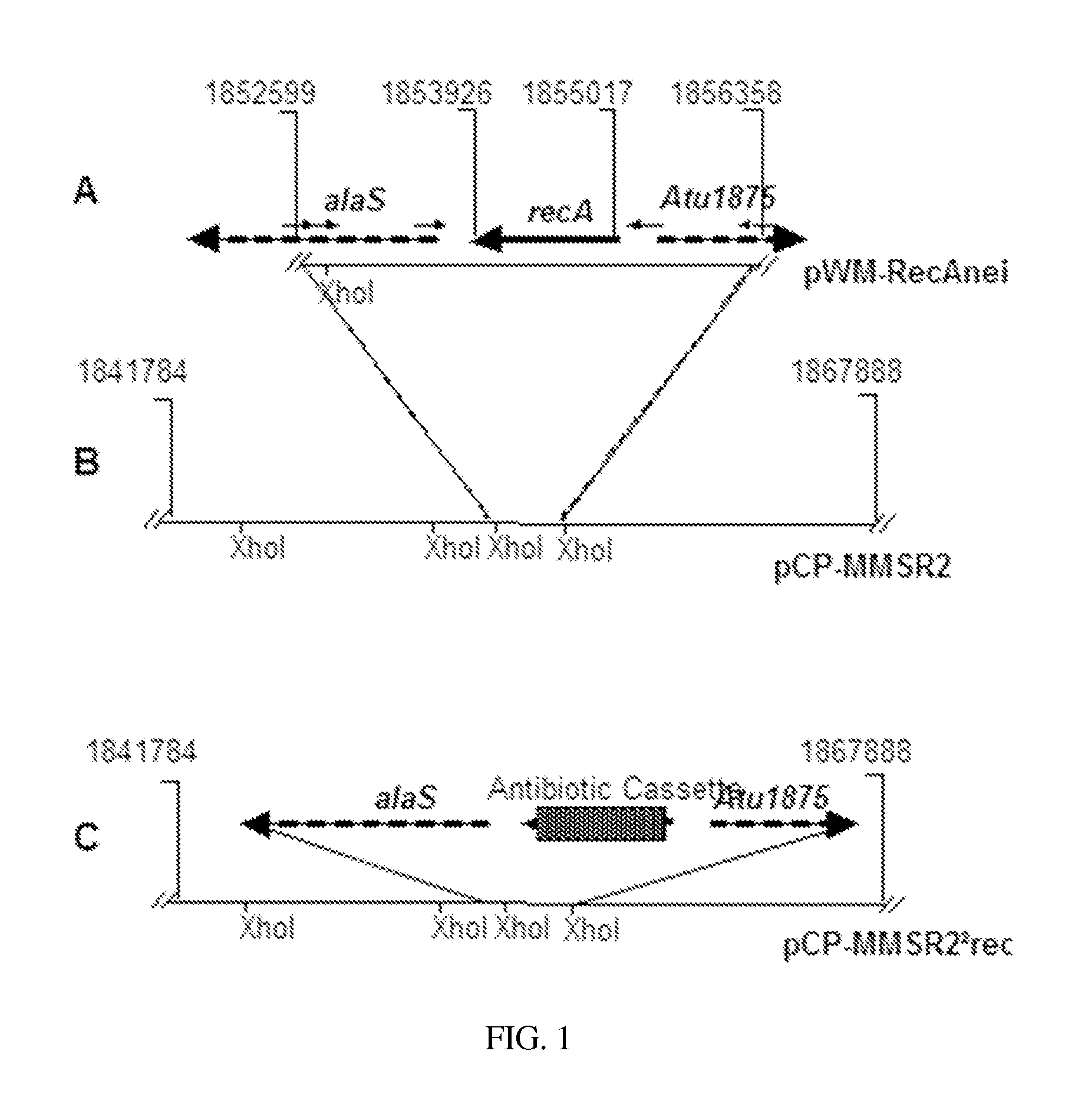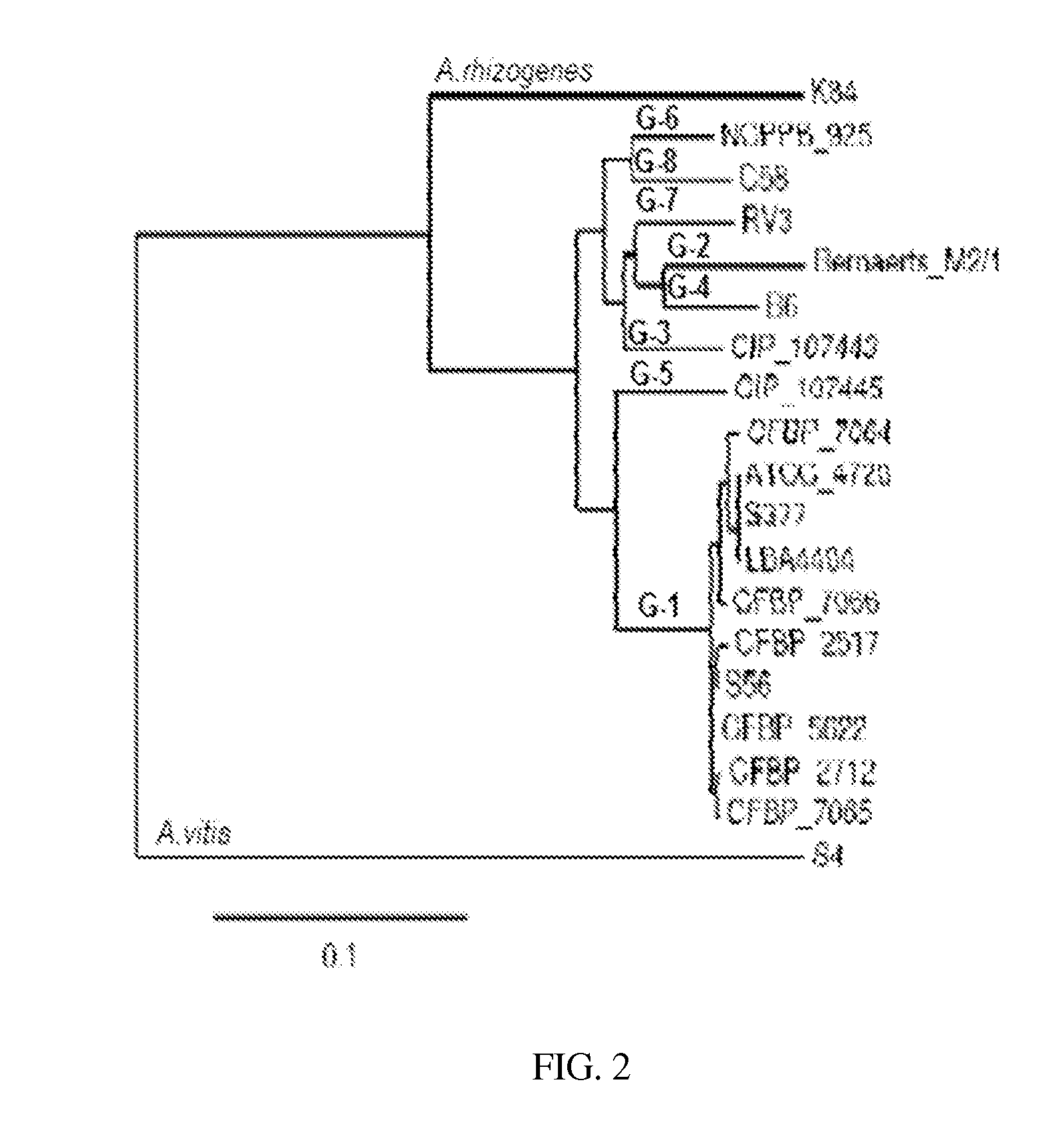Methods and compositions for recombination a gene-deficient strains of agrobacterium tumefaciens
a technology of agrobacterium tumefaciens and agrobacterium, which is applied in the field of methods and compositions for recombination of gene-deficient strains of agrobacterium tumefaciens, can solve the problems of reducing the efficiency of plant transformation, requiring thoroughness, and unstable transformation of plasmids within this strain
- Summary
- Abstract
- Description
- Claims
- Application Information
AI Technical Summary
Benefits of technology
Problems solved by technology
Method used
Image
Examples
example 1
Construction of an Agrobacterium tumefaciens (LBA4404) Genomic Library and Isolation of recA Plus Cosmid Clones
[0163]A genomic DNA library is constructed to isolate and identify the previously uncharacterized recA gene from Agrobacterium tumefaciens (LBA4404). Genomic DNA from A. tumefaciens (LBA4404) is partially digested with the restriction enzyme Sau3A1 (New England Biolabs, Ipswich, Mass.), and is fractionated by centrifugation on a 10-40% discontinuous sucrose gradient in a buffer (20 mM Tris-HCl, pH 8.0; 10 mM EDTA; and, 50 mM NaCl). Fractions containing genomic DNA fragments with sizes spanning a range of about 20-40 kb are pooled and ligated into the broad-host-range cosmid vector, pCP13 / B (tetracycline-resistant) (Dessaux Y, Tempé J, Farrand S K. 1987. Genetic analysis of mannityl opine catabolism in octopine-type Agrobacterium tumefaciens strain 15955. Mol Gen Genet. 208(1-2):301-8). This cosmid vector is treated with BamHI and alkaline phosphatase before use in the ligat...
example 2
Cloning, Characterization, and Sequence Analysis of the recA Gene from A. tumefaciens (LBA4404)
[0165]To construct the recA gene knock-out strains of A. tumefaciens (LBA4404), the location of the recA gene is assessed to determine if the location of the recA gene is present in the same genomic context as other recA gene isolates from Agrobacterium and Rhizobium species (Goodner B et al., 2001. Genome sequence of the plant pathogen and biotechnology agent Agrobacterium tumefaciens C58. Science 2942323-2328; and, Slater S C et al., 2009. Genome sequences of three Agrobacterium biovars help elucidate the evolution of multi-chromosome genomes in bacteria. J Bacteriol. 191(8):2501-11). Accordingly, the neighboring sequences located upstream and downstream of recA from A. tumefaciens (C58), A. vitis (S4), A. radiobactor (K84), Rhizobium leguminosarum and Rhizobium sp. NGR234, are searched for highly conserved sequences to design primers (F-recAnei and R-RecAnei in Table 1). These sequences...
example 3
Replacement and Disruption of the recA Gene in MMS-Resistant Cosmids with a Kanamycin or Chloramphenicol-Resistance Cassette
[0167]The bacteriophage λ-based red recombination is used to introduce antibiotic resistance cassettes into the recA gene of A. tumefaciens (LBA4404) carried on pCP-MMSR2 (Datsenko K A, Wanner B L. 2000. One-step inactivation of chromosomal genes in Escherichia coli K-12 using PCR products. Proc Natl Acad Sci USA. 97(12):6640-5). Briefly, using primers F-recA-frt and R-RecA-frt listed in Table 1, DNA fragments encoding the chloramphenicol and kanamycin antibiotic resistance genes are amplified from pKD3 and pKD4, respectively. These amplified PCR fragments encoding the antibiotic cassettes are flanked with 43 bp sequences located upstream and downstream of the recA gene. The sequences further included 9 bp from each end of the recA gene. The resulting linear PCR amplification products are electroporated into the E. coli (HB101) strains that harbored the MMS-res...
PUM
| Property | Measurement | Unit |
|---|---|---|
| Fraction | aaaaa | aaaaa |
| Electrical resistance | aaaaa | aaaaa |
| Strain point | aaaaa | aaaaa |
Abstract
Description
Claims
Application Information
 Login to View More
Login to View More - R&D
- Intellectual Property
- Life Sciences
- Materials
- Tech Scout
- Unparalleled Data Quality
- Higher Quality Content
- 60% Fewer Hallucinations
Browse by: Latest US Patents, China's latest patents, Technical Efficacy Thesaurus, Application Domain, Technology Topic, Popular Technical Reports.
© 2025 PatSnap. All rights reserved.Legal|Privacy policy|Modern Slavery Act Transparency Statement|Sitemap|About US| Contact US: help@patsnap.com



